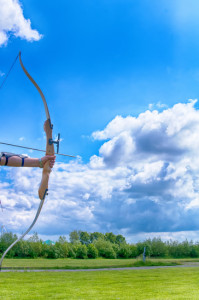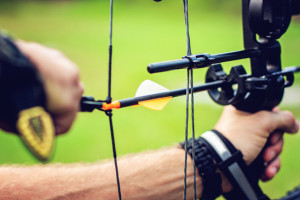Bows and arrows have been in use for thousands of years for defense, offense, hunting, and for pleasure sport. While the bow has a rich history across the world, some types of bows have been developed and in use for far shorter a time. One such type, the compound bow, was invented in modern times and features modern technology. The recurve bow, however, is also a popular bow and was first designed thousands of years ago. These two bows are widely used today for various activities that suit each bow’s capabilities.
The Recurve Bow
 The classic recurve bow may be described as a bow that has limbs that curve away from its user when not in use. The recurve bow is known for its string that rests across the curved limbs; this demonstrates the depth of the curve of this bow. As the archer knocks an arrow, the string is pulled back, removing it from resting on the limbs as they are fully extended. Many cultures used composite recurve bows, or bows made from layering multiple materials in order to increase strength, including the Huns, Persians, Greeks, Turks, Mongols, and Chinese.
The classic recurve bow may be described as a bow that has limbs that curve away from its user when not in use. The recurve bow is known for its string that rests across the curved limbs; this demonstrates the depth of the curve of this bow. As the archer knocks an arrow, the string is pulled back, removing it from resting on the limbs as they are fully extended. Many cultures used composite recurve bows, or bows made from layering multiple materials in order to increase strength, including the Huns, Persians, Greeks, Turks, Mongols, and Chinese.
In addition to these warrior cultures, many more civilizations used these weapons until utilization of firearms during battle made archers obsolete and unneeded.
Modern recurve bows are still used for a variety of activities. The recurve bow has also attained new popularity from its use in the Hunger Games franchise where its female protagonist uses the recurve bow as her weapon of choice to provide for her family, and ultimately in a battle to the death. This proves the recurve bow has not been lost to the modern sportsman/woman and is a weapon that has held its own over time.
Current uses for recurve bows include target practice, sport archery, and different hunting applications. Although some professionals would recommend a compound bow for hunting game, expert hunters across the country argue that any animal can be successfully hunted with a recurve bow. Because the recurve bow is better for on-the-fly targeting for animals that may be moving, it also does better with small game such as:
- Rabbit
- Beaver
- Wild turkey
- Small game birds
The recurve bow is also the bow of choice at the Olympic Games and has been since the sport began in the games in 1900. In more recent years, bow-fishing has popped up in popularity where the archer spears a fish with an arrow that is attached to a reeled line. The fish is then reeled up to the boat and netted. This sport is relatively new, but has gained popularity recently and is useful in catching a variety of fish such as carp, grass carp, bighead carp, alligator gar, and paddlefish.
This bow undoubtedly has many uses; here are some of the pros to using a recurve bow:
- Cheaper price
- Made from more natural materials
- Less complicated
- Easy to maintain
- No serious adjustments needed
- Simplistic shooting style
Even though there are many pros, there undoubtedly are bound to be cons as well. Some of the possible downsides to using a recurve bow include:
- Takes more skill to make accurate
- Can be less powerful
- Expert level required for difficult shots
Now that we have discussed the pros and cons of the recurve bow, we will take a closer look at the compound bow, and its applications versus the recurve bow.
Compound Bow
 The compound bow is a relatively modern bow (first developed in 1966) that uses a system of cables and pulleys to bend the limbs under tension. This type of bow is popular with big game hunters and can be used competitively. Compound bows can be extremely accurate, as well as more powerful than other bows. The pulley system effectively allows the archer to use less strength to draw the bow, storing more energy in the stiffer limbs with less effort.
The compound bow is a relatively modern bow (first developed in 1966) that uses a system of cables and pulleys to bend the limbs under tension. This type of bow is popular with big game hunters and can be used competitively. Compound bows can be extremely accurate, as well as more powerful than other bows. The pulley system effectively allows the archer to use less strength to draw the bow, storing more energy in the stiffer limbs with less effort.
This bow is popular with hunting of all game types. It is very quiet, allowing for hunter’s to surprise even the most noise-sensitive animals and it doesn’t clear the forest after a shot like a firearm does.
Some of the hunting applications for a compound bow include:
- Deer
- Boar
- Bear
- Moose
- Caribou
- Large game
In addition to game hunting, the compound bow has also erupted into the bow-fishing world as the bow of choice for salt-water fishing. With their superior power, compound bows have proved useful with catching stingrays and different types of sharks.
There is no doubt that the compound bow is a powerful and versatile weapon. There are many other pros to using a compound bow:
- Sturdy construction
- Less skill needed to operate
- Powerful force
- Very accurate
- Much quieter than other weapons
- Lightweight
- More technologically advanced
Despite the many advantages, there are a few cons to using this type of bow:
- Lightweight design can interfere with accuracy
- More moving parts can mean more breakdowns
- Harder to repair
- Cost more on average
- More expensive to maintain
The compound bow is definitely a powerful weapon and can be used in many applications. The modern design has helped bring a new generation of archers into the world. By enhancing this basic weapon with technological advances, it has brought this weapon into the present; it is no longer a weapon of the distant past.
Compound vs. Recurve Bows
So who wins the battle between the two types of bows? Neither! Both bows are strong and reliable contenders and are useful in their own ways. The recurve is the best for small game hunting, bow-fishing, and general use by a more advanced archer, whereas the compound bow is better for large game hunting, sea bow-fishing, and is popular with archers of all ages and skill level.
